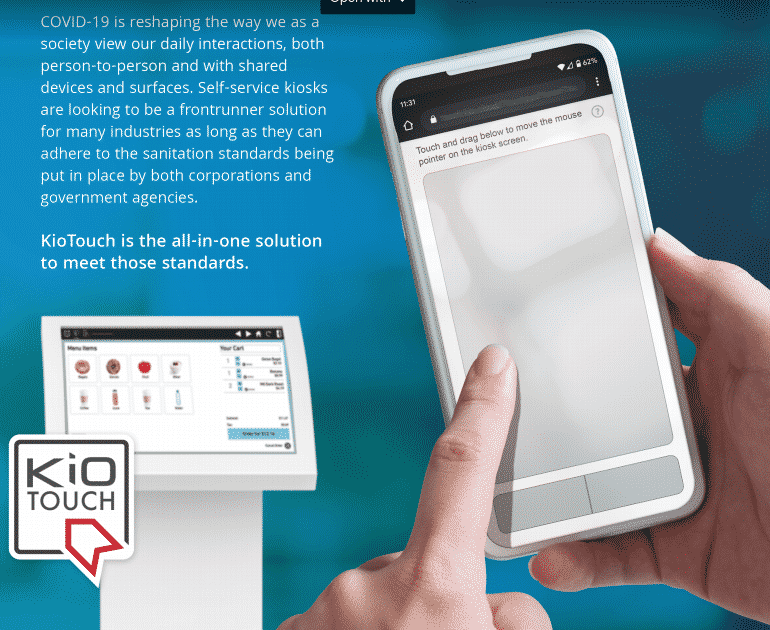
By: Chris Fravel, Marketing Specialist for KioWare Kiosk System Software
COVID-19 has shifted the way we as a society views cleanliness and personal hygiene. There is a new importance placed upon these principles that many people are prioritizing over everything else in their day-to-day activities as evidenced by industries shifting to a mostly work-from- home -style schedule. When people aren’t in the safety of their own homes, it’s not uncommon to see them regularly applying hand sanitizer,; wearing masks in public areas,; and keeping an appropriate social distance from other people; and more habits that were not commonly seen before the global pandemic of 2020.
That begs the question as to how businesses can maintain regular operations while also keeping in mind the newfound importance of minimizing the spread of bacteria. A growing number of businesses is discovering that implementing a touchless interface to their self-service kiosks covers most of those bases. This is how a touchless kiosk interface does it:
1. A touchless kiosk interface allows for the same interaction without physically contacting the surface of the self-service device. Minimizing the amount of contact an end-user has with your self-service kiosk is one thing, eliminating it is another thing entirely. This can be accomplished by scanning a QR code to access a secure connection between the kiosk device and the end-user’s personal mobile device.
2. Maintaining a self-service kiosk option allows end-users to avoid person-to-person contact with your human workers. Over the past few months, researchers have narrowed down the most common way to transmit COVID-19: person-to-person. It is estimated that interactions between unmasked COVID-19 carriers and unmasked healthy individuals have a 90% chance of resulting in a healthy individual becoming infected. Masks greatly reduce the spread of infection but do not eliminate it, so providing self-service options to minimize person-to-person interactions where possible is essential.
3. Implementing a touchless kiosk solution helps the sanitization supply chain recover. Over the past five months, it has been extremely difficult to purchase cleaning and sanitization supplies. These products have been in such high demand to maintain a level of social cleanliness that suppliers have been operating on a perpetual back-order status since the start of the pandemic, and an alternate solution could alleviate some of that stress on the supply chain. Allowing people to interact with a kiosk through their own personal device will create a gap where products like hand sanitizer or sanitizing wipes would normally be used to reduce the chance of pathogen spread. That begs the question as to how businesses can maintain regular operations while also keeping in mind the newfound importance of minimizing the spread of bacteria. A large number of businesses have discovered that implementing a touchless interface to their self-service kiosks has covered most of those bases. Here’s how a touchless kiosk interface does it:
4. A touchless kiosk interface allows for the same interaction without physically contacting the surface of the self-service device. Minimizing the amount of contact an end-user has with your self-service kiosk is one thing, eliminating is another thing entirely. This can be accomplished in a number of ways, one of them is scanning a QR code to access a secure connection between the kiosk device and the end-user’s
personal mobile device.
5. Maintaining a self-service kiosk option allows for end-users to avoid person-to-person contact with your human workers. Over the past few months, researchers have narrowed down the most common way to transmit COVID-19: person-to-person. It’s estimated that interactions between an unmasked COVID-19 carrier and an unmasked healthy individual has a 90% chance of resulting in the healthy individual becoming infected. Adding masks to the two hypothetical people in those scenarios begins to reduce the chance of infection, but never completely eliminates it. While COVID-19 can still be spread by touching some surfaces contaminated with the virus, it is far less likely to infect a person compared to a person-to-person interaction.
6. Implementing a touchless kiosk solution allows resources that are being otherwise drained to maintain a level of social cleanliness to recover due to a lack of necessity. Over the past five months it has been extremely difficult for anyone, businesses and consumers alike, to purchase cleaning and sanitization supplies like liquid solutions and paper products. There has been such a high demand that suppliers have been operating on a perpetual back-order over the duration of the pandemic and an alternate solution could alleviate that stress on the supply chain. Allowing for people to interact with kiosk through their own personal device will create a gap where products like hand sanitizer or sanitary wipes would normally be used to reduce the chance of pathogen spread.
To address the issue of spreading germs via kiosk touch screens long before COVID, KioWare Kiosk System Software began development on a touchless interface. The impact of COVID-19 accelerated development, and last month, KioWare introduced Allow me to introduce KioTouch™ — the a touchless kiosk interface solution designed by KioWare Kiosk System Software. KioTouch allows for an end-user to interact directly with a kiosk via their personal mobile device by scanning a QR code that is displayed on the attract screen. At that point, a trackpad-style mouse is displayed on the end-user’s device, giving them complete control of the kiosk ’s screen functionsjust as they would have control during normal, physical interface. The trackpad is responsive to clicks, swipes, and all other normal mouse functions. When If a field requires text to be entered, a simple click into the text field ofusing the trackpad onto the field will bring up a keyboard on the end-user’s device, allowing them to enter text as if they were sending a text message or e-mail. At the conclusion of the user’s session, KioTouch can be programmed to display content of the kiosk deployer’s choosing such as, but not limited to, a website, loyalty app, newsletter, or simple “thank you” message.
If you would like to see KioTouch in action, click here .
KioTouch is compatible with any kiosk system software and can be installed on any self-service device, whether it be a full-sized kiosk unit built into a display or a smaller device that would normally be handheld for the end-user. KioWare is not required to run KioTouch, but it is integrated into the latest versions of KioWare for Windows and KioWare for Android and easily activated with a subscription license. and can be installed on any self-service device, whether it be a full-sized kiosk unit built into a display or a smaller device that would normally be handheld for the end-user.
The world around us is changing. People are viewing the world through a new lens, one that emphasizes the importance of reducing germ and pathogen spread. This new perspective means businesses are going to need to get be creative with accommodating the sanitary desires of its customers or continue to deal with closures and limited services due to mandates put in place by governments. Creating a touchless experience with a seamless interface on self-service kiosks without sacrificing a seamless interface will be crucial to thriving in this new era of limited human interaction and higher standards of cleanliness and sanitation.
Are you prepared?
KioTouch Ad 2020 KioTouch Ad 2020-compressed
For Touchless Kiosk Software Contact KioWare
[contact-form to=”[email protected],[email protected]” subject=”KioWare Touchless”][contact-field label=”Name” type=”name” required=”1″][contact-field label=”Email” type=”email” required=”1″][contact-field label=”Website” type=”url”][contact-field label=”Message” type=”textarea”][/contact-form]

